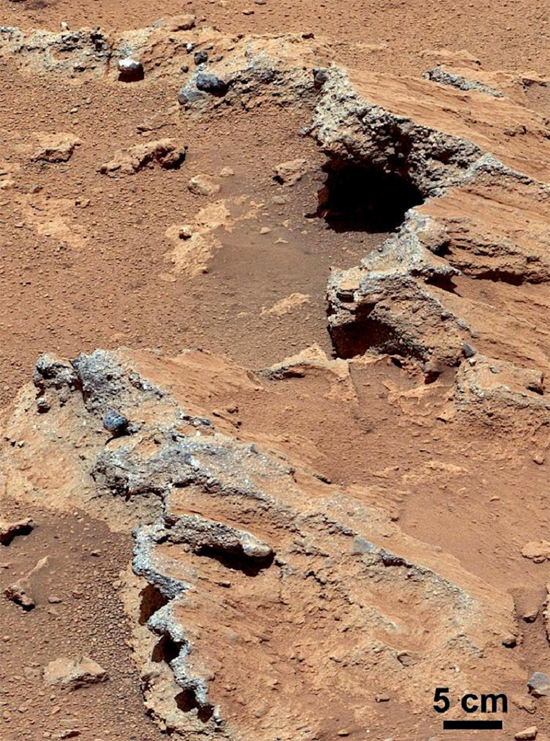Aug 11, 2014
Several previous Picture of the Day articles take issue with the idea that Mars once flowed with liquid water.
Since Mars is now a freeze-dried, barren wasteland of rocks and dust, it is presumed that the supposed water features there evaporated over millions of years. When the Mars Global Surveyor (MGS) entered orbit around Mars in 1997, the extremely high resolution cameras captured images that suggest layered rock extending for thousands of kilometers through the Schiaparelli Basin and out into Valles Marineris. The layers with similar thickness prompted NASA scientists to conclude that the strata in Schiaparelli Basin is actually sedimentary, and might have built-up in water and then been eroded by wind.
Mars is thought to be covered with a global layer of ice because the annual temperature of the soil is approximately minus 50 Celsius. In the last few years, several Mars missions have sought to confirm the existence of water in some form or another on the Red Planet. Although there have been reports of clouds and low-lying fog, and the Phoenix polar lander is reputed to have detected water just below the surface, there has been nothing definitive that can stand up to close scrutiny. For example, although the now defunct Phoenix lander is said to have found visual evidence for water, the probes used to test for water in the soil returned a null reading. The soil was nonconductive, indicating no water molecules.
However, according to a relatively recent press release, the Mars Science Laboratory rover known as “Curiosity” has found what planetary scientists are calling an ancient stream bed in Gale Crater. The reason they refer to it as a stream bed is due to the rock slabs that contain a conglomeration of rounded pebbles.
As Rebecca Williams from the Planetary Science Institute wrote: “These conglomerates look amazingly like streambed deposits on Earth. Most people are familiar with rounded river pebbles. Maybe you’ve picked up a smoothed, round rock to skip across the water. Seeing something so familiar on another world is exciting and also gratifying.”
There are several sizes of gravel embedded in the rock, from sand to pebbles the size of golf balls. In Hottah, shown at the top of the page, the pebbles are alternately layered with sand, a feature found in dry water courses here on Earth. Other observations seem to suggest that there was a continuous flow of water, rather than a one time event.
A long-hoped-for desire among researchers studying Mars is that the Red planet could be a cradle for different life forms that arose and evolved in a separate ecology. As nearly every presentation about Mars insists, the planet must have gone through a stage when there were oceanic quantities of liquid water on the surface. This idea also implies that Mars once retained an atmosphere dense enough in oxygen (and a moderating gas) so that life could live in the open.
However, there is disagreement in the scientific community about whether such volumes of water could ever have existed on Mars. it was reported in the March 5, 2007 edition of Scientific American that most of what has been interpreted as water-based erosion on Mars could have come from “dry avalanches” of dirt. The authors expressed serious doubts about whether observations have demonstrated any effects caused by liquid water.
In previous Picture of the Day articles about Mars, it was noted that powerful electric arcs once impacted the surface. The incredible energy released by those plasma discharges took the form of sinuous rilles, flat-floored craters, “railroad track” patterns in canyons and craters, intersecting gullies with no debris inside them, giant mesas with Lichtenberg “whiskers” and steep-sided ravines wending through landscapes dotted with circular uplifts.
The remnant topography on Mars is not rounded or softened as if by a deluge, nor does it conform to slow weathering by rainfall or blowing dust. The formations are sharp, angular and fresh looking, as if they were sculpted quickly and with tremendous force.
The northern latitudes, in particular, appear to have been obliterated. In fact, Electric Universe theorist Wal Thornhill has written that the northern region of Mars was the scene of a cosmic plasma storm that electrically sputtered millions of square kilometers out of the crust, subsequently redistributing the finely divided dust all over the rest of the planet as well as hurling it into space. Such an event would preclude the remains of water-based formations, since the majority of the planet was catastrophically resurfaced.
Stephen Smith













